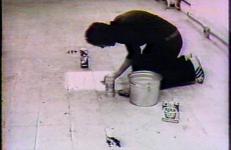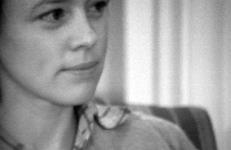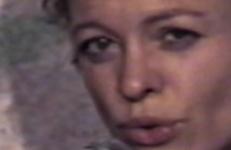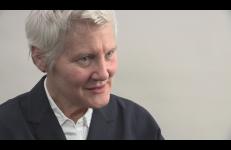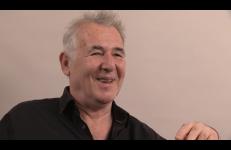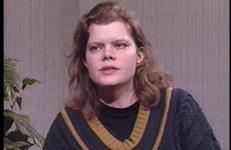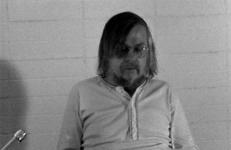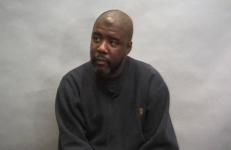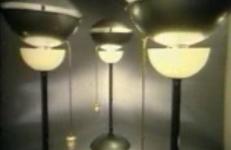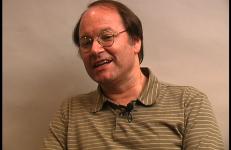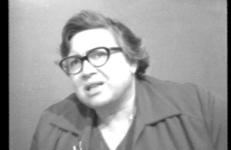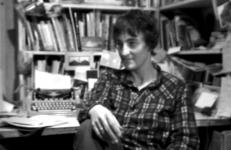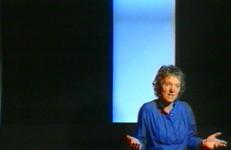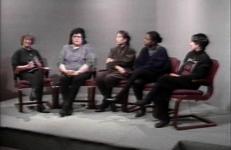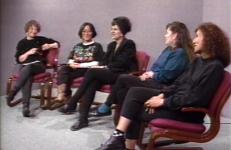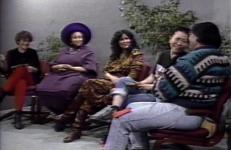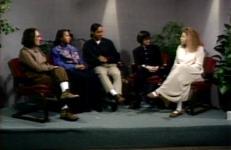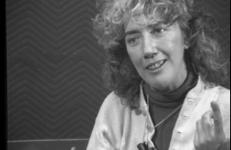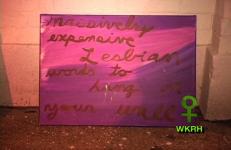This video presents a history of alternative spaces in New York City during the late 1960s and early 1970s, focusing on two galleries that no longer exist. The work produced in these two spaces forms the basis of the New Museum of Contemporary Art’s 1981 exhibition Alternatives in Retrospect: An Overview 1969-1975. Curator Jacki Apple, who produced the video, assembled documentation from the galleries and reconstructed artworks for the exhibition.
Art Criticism
Laurie Anderson (b. 1947) began her career as a gallery artist specializing in photography, before moving to critical work as a writer for Art News and Art in America. She later returned to the art world, making groundbreaking multimedia performance art. Her most widely known work dates back to the early-to-mid-’80s, and is marked by an innovative use of technology in blending media-based and staged performance.
Laurie Anderson is perhaps best known as a performance artist who works in both the art and commercial worlds. Anderson talks to Steven Poser through a voice manipulator, commenting on how performing abroad has informed her work and her perspective on American culture, especially regarding issues of language and voice in communication.
This video was produced for the Artists TV Network series Conversations.
In conversation with curator and educator Mary Jane Jacob, visual artist Ann Hamilton (b. 1956) talks about care, interactivity, and social relations — key concepts that preoccupy her practice — and why she feels compelled to revisit these issues under the Trump administration. Hamilton was trained in textile design and sculpture, and she received her MFA from Yale University School of Art in 1985.
Magenheimer’s video explores the bounds of narrative and the illusion of received wisdom in the seven minutes and twenty-two seconds it takes to rob a house. Here, images of medieval art, popular cinema, and “live” news reportage speak candidly to the constructedness of all storytelling traditions.
Commissioned by the Oakland Museum, this video provides an artist’s interpretation of the museum’s displays and collections. The voice of a friendly narrator enlarges the image-objects with historical and social information, while a written text provides ironic commentary. “The term curator is derived from the Latin ‘curatus’ —one responsible for the care of souls.” The daughter represented in the famous Dorthea Lange photograph of the Migrant Mother recounts the circumstance surrounding the now-celebrated photograph and how it impacted her life.
Julie Ault is an artist, curator, and founding member of the artist collective Group Material, which has organized exhibitions on themes such as the U.S.’s involvement in Central America, AIDS, education, and mass consumerism. Her exhibitions question traditional gallery and museum systems by asking “how is culture made and for whom?”
Interview by Michael Crane.
"One of Baldessari’s most ambitious and risky efforts. Seated and holding a sheaf of papers, he proceeds to sing each of Sol LeWitt’s 35 conceptual statements to a different pop tune, after the model of Ella Fitzgerald Sings Cole Porter. What initially presents itself as humorous gradually becomes a struggle to convey Lewitt’s statements through this arbitrary means."
—Helene Winer, “Scenarios/Documents/Images,” Art in America 61 (March 1973)
British theorist and art historian Eddie Chambers (b.1960) is a curator and a regular contributor to Art Monthly and European journals on contemporary art. His writings were collected in Run Through the Jungle (1999). Since the early 1980s he has been involved in organizing and curating a considerable number of artists' exhibitions. In addition to his exhibition work, he has written extensively about the work of artists in the United Kingdom and other countries, including Australia, Jamaica and the U.S. His articles and other texts have been widely published in magazines and journals such as Third Text, Visual Culture in Britain, International Review of African American Art, and Wasafiri.
In this rare and humorous record of the art dialogue of the late 1960s, Holt and "guest" Robert Smithson assume opposing artistic viewpoints: the uptight, intellectual New Yorker versus the laid-back Californian. Their play-acting lays bare the cliches and stereotypes of a "bi-coastal" art world. While Holt stresses analytic, systematic thinking, Smithson represents the polar opposite, privileging visceral experience and instinct, saying, "I never read books; I just go out and look at the clouds." and "Why don't you stop thinking and start feeling?"
R.M. Fischer’s lamp sculptures, made from found industrial parts in a hybrid style of high-tech slickness and Baroque exaggeration suggested parodies of industrial commercials. The narration sounds like advertising hype but is actually composed from critical reviews of Fischer’s work. The slick, serious look of the final tape was accomplished in part by using a professional voiceover actor, a commercial photographer, and music composed for a brand-name commercial.
Conceptual artist Hans Haacke’s two most notorious works took unsavory Manhattan real-estate dealing as their subject, which triggered the cancellation of his exhibition Real Time Social System at the Guggenheim Museum in 1971. With the conscientiousness of an investigative reporter, Haacke continues to scrutinize the rough edges between art and life.
In this interview, Brian Holmes, an influential art critic, activist and translator, discusses social forms of alienation, human ecologies of power, and the impact of technology on geopolitical social networks. Holmes reflects on his ongoing study of the ways in which the rhetoric of revolution has been institutionalized, as well as artists’ resistance to such cooption. For him, artists working in collectives have the potential to create a new artistic milieu that is not aligned with the dominant model of production. This argument is born out in his published collection of essays, Hieroglyphics of the Future (2003).
Estelle Jussim (1928-2004) was regarded as one of the most influential voices in photography and media. An art historian and a communications theorist, Jussim wrote extensively about photographers, movements, and institutions, incorporating postmodern, deconstructionist, and feminist viewpoints in her many writings without being hemmed in by any one critical ideology. Jussim was the award-winning author of Slave to Beauty and the pioneering Visual Communication and the Graphic Arts, which charted new ground in the investigation of the meaning of images.
Lucy Lippard (b. 1937) earned degrees from Smith College and New York University before beginning her career as an art critic in 1962, when she began contributing to publications such as Art International and, later, Artforum. In 1966, she organized an exhibition entitled “Eccentric Abstraction” at the Fischbach Gallery in New York City. “Eccentric Abstraction” set the standard for what would later be regarded as postminimalism, process, or antiform art.
The Luminous Image was an international exhibition of video installations held in the fall of 1984 at the Stedelijk Museum in Amsterdam.
Nathan Lyons (b.1930) has contributed to the field of photography as a critic, author, curator, educator, and photographer. He has published several books and catalogs, including Photographers on Photography (1966), Photography in the 20th Century (1967), Towards a Social Landscape (1967), Persistence of Vision (1968), and Notations in Passing (1974). His body of work consists primarily of photographs which focus on American culture.
Annette Michelson is a founding editor of the journal October and former professor of cinema studies at New York University. Before starting October, Michelson was the film critic for Artforum. Michelson’s influential work has focused on modernity, Russian and French avant-garde film, and American underground cinema.
The third in a series of cross-cultural symposia organized by Lucy Lippard, the four artists interviewed here—Jean Lamar, Hung Liu, Lorna Simpson, and Kathy Vargas—discuss their work and its cultural contexts. Moderated by Lucy Lippard.
The fourth in a series of cross-cultural symposia organized by Lucy Lippard, the four artists interviewed hereÑJapanese-American painter and political activist Betty Kano, conceptual and performance artist Lorraine O'Grady, Hopi weaver Ramona Sakiestewa, and Chicana narrative and installation artist Celia Alvarez Muñoz–discuss their work and its cultural contexts.
The fifth in a series of cross-cultural symposia organized by Lucy Lippard, the four artists interviewed here–Tejana tableaux artist Santa Barranza, Taiwanese video and interactive installation artist Shu Lea Cheang, African-American sculptor and installation artist Joyce Scott, Native-American photographer Hulleah Tsinhnahjinnie–discuss their work and its cultural contexts. Moderated by Lucy Lippard.
The sixth in a series of cross-cultural symposia organized by Lucy Lippard, the four artists interviewed here–gay activist and self portrait artist Lyle Ashton Harris, Chicano photographer and tourist Robert Buitron, Cherokee writer, curator, and video creator Rayna Green, photography critic and professor at University of California-Irvine Catherine Lord, and Chinese-American video artist Valerie Soe–discuss the role of photography and creation of culture. Moderated by Lucy Lippard.
The seventh in a series of cross-cultural symposia organized by Lucy Lippard, the four artists interviewed here–visual anthropologist Wendi Starr-Brown, Hapa video and performance artist Kip Fulbeck, Japanese-American artist Dorothy Imagire, Chicana mixed-media artist Yolanda López–address the role of mixed-race identity in their work. Moderated by Corissa Schweitz Gold.
Elizabeth Murray (1940-2007) was an American painter, printmaker and draughtsman. She studied at the Art Institute of Chicago (1958–62) and at Mills College, Oakland, CA (1962–4). Elizabeth Murray’s paintings have been referred to as “dandyish abstraction.” Her work is distinctive in its use of color, shape, and surface to evoke human characteristics, personalities or humor. Murray is particularly well known for her shaped canvases, which date from 1976, on to which are painted both figurative and non-figurative elements.
The second installment of the collaborative project New Report, an ongoing series of performances and videos, Artist Unknown features K8 Hardy (founder of the queer feminist art collective LTTR) and Wynne Greenwood (of Tracy and the Plastics) playing Henry Irigaray and Henry Stein-Acker-Hill, and anchor and roving correspondent for WKRH, a feminist TV news station whose tagline is "pregnant with information." Based on documentation of a live, digital communication in real time between Greenwood at Foxy Production Gallery and Hardy on the street in New York.




